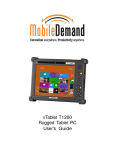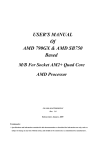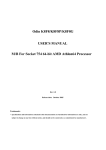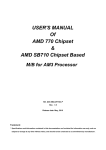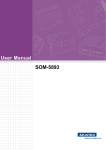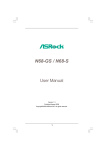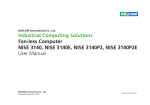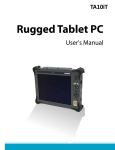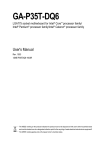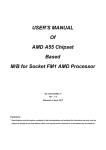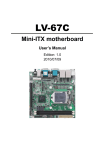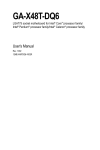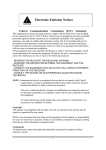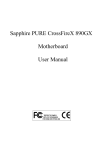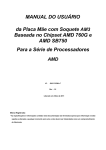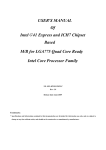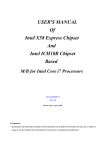Download USER`S MANUAL Of AMD 785G & AMD SB710 Based
Transcript
USER'S MANUAL Of AMD 785G & AMD SB710 Based M/B For Socket AM3 Series Quad Core Processor NO. G03-MA3785GP-F Rev:1.0 Release date: Aug., 2009 Trademark: * Specifications and information contained in this documentation are furnished for information use only, and are subject to change at any time without notice, and should not be construed as a commitment by manufacturer. Environmental Protection Announcement Do not dispose this electronic device into the trash while discarding. To minimize pollution and ensure environment protection of mother earth, please recycle. ii TABLE OF CONTENT USER’S NOTICE .........................................................................................................iii MANUAL REVISION INFORMATION .........................................................................iii COOLING SOLUTIONS ..............................................................................................iii CHAPTER 1 INTRODUCTION OF AMD 785G MOTHERBOARDS 1-1 1-2 1-3 1-4 FEATURES OF MOTHERBOARD ............................................................................. 1 1-1.1 SPECIAL FEATURES OF MOTHERBOARD ............................................... 2 SPECIFICATION ......................................................................................................... 3 PERFORMANCE LIST................................................................................................ 4 LAYOUT DIAGRAM.................................................................................................... 5 CHAPTER 2 2-1 2-2 2-3 2-4 2-5 2-6 2-7 HARDWARE INSTALLATION HARDWARE INSTALLATION STEPS ....................................................................... 7 CHECKING MOTHERBOARD'S JUMPER SETTING................................................ 7 INSTALL CPU ............................................................................................................. 8 2-3-1 GLOSSARY................................................................................................... 8 2-3-2 ABOUT AMD AM3 INSTALLATION .......................................................... 9 INSTALL MEMORY .................................................................................................... 10 EXPANSION CARDS.................................................................................................. 11 2-5-1 PROCEDURE FOR EXPANSION CARD INSTALLATION .......................... 11 2-5-2 ASSIGNING IRQS FOR EXPANSION CARD .............................................. 11 2-5-3 PCI-EXPRESS SLOT ...................................................................................... 11 CONNECTORS, HEADERS ...................................................................................... 12 2-6-1 CONNECTORS ............................................................................................. 12 2-6-2 HEADERS ..................................................................................................... 15 STARTING UP YOUR COMPUTER ........................................................................... 18 CHAPTER 3 INTRODUCING BIOS 3-1 3-2 3-3 3-4 3-5 ENTERING SETUP ..................................................................................................... 19 GETTING HELP .......................................................................................................... 19 THE MAIN MENU........................................................................................................ 20 STANDARD BIOS FEATURES .................................................................................. 21 ADVANCED BIOS FEATURES .................................................................................. 22 3-5-1 CPU CONFIGURATION ............................................................................. 23 3-6 ADVANCED CHIPSET FEATURES ........................................................................... 23 3-6-1 MEMORYCONFIGURATION ..................................................................... 24 3-6-2 INTERNAL GRAPHICES CONFIGURATION ............................................ 25 3-6-3 PCI EXPRESS CONFIGURATION ............................................................ 25 3-7 INTEGRATED PERIPHERALS................................................................................... 26 3-7-1 ONBOARD SATA DEVICE.......................................................................... 26 3-7-2 ONCHIP DEVICE CONTROL ...................................................................... 26 3-7-3 SUPER IO CONFIGURATION ..................................................................... 27 3-8 POWER MANAGEMENT SETUP............................................................................... 27 3-9 MISCELLANEOUS CONTROL ................................................................................. 28 3-10 PC HEALTH STATUS.................................................................................................. 29 3-10-1 SMART FAN CONFIGURATION .................................................................. 29 3-11 THERMAL THROTTLING OPTIONS........................................................................... 30 3-12 POWER USER OVERCLOCK SETTING .................................................................. 30 3-13 BIOS SECURITY FEATURES................................................................................... 31 3-14 LOAD OPTIMISED DEFAULTS /LOAD STANDARD DEFAULTS .......................... 31 3-15 SAVE CHAGES AND EXIT/DIACARD CHANGES AND EXIT ................................ 32 CHAPTER 4 DRIVER & FREE PROGRAM INSTALLATION MAGIC INSTALL SUPPORTS WINDOWS 2000/XP/VISTA/WINDOES7........................... 33 4-1 ATI INSTALL ATI DRIVER PACK ....................................................................... 34 4-2 SOUND INSTALL HD CODEC AUDIO DRIVER ................................................... 35 4-3 LAN INSTALL GIGABIT ETHERNET NIC DRIVER................................................. 36 4-4 RAID INSTALL ATI SATA DRIVER AND UTILITY .................................................... 36 4-5 NORTON INSTALL NORTON 2009ANTI-VIRUS PROGRAM................................... 37 4-6 PC-HEALTH INSTALL MYGUARD HARDWARE MONITOR UTILITY .................. 37 4-7 PC-HEALTH INSTALL MYGUARD HARDWARE MONITOR UTILITY .................. 37 4-8 HDMI INSTALLATI HDMI AUDIO DRIVER ............................................................. 38 ii 4-9 OVERCLOCK INSTALL OVER CLOCK DRIVER UTILITY ....................................... 38 4-10 HOW TO UPDATE BIOS ............................................................................................ 40 4-11 AMD PLATFORM RAID FUNCTION INSTALLATION .............................................. 40 4-12 G.P.I FUNCTION LED DISPLAY ................................................................................ 44 APPENDIX I.......................................................................................................................... 45 Safety Environmental Instruction z Avoid the dusty, humidity and temperature extremes. Do not place the product in any area where it may become wet. z 0 to 40 centigrade is the suitable temperature. (The figure comes from the request of the main chipset) z Generally speaking, dramatic changes in temperature may lead to contact malfunction and crackles due to constant thermal expansion and contraction from the welding spots’ that connect components and PCB. Computer should go through an adaptive phase before it boots when it is moved from a cold environment to a warmer one to avoid condensation phenomenon. These water drops attached on PCB or the surface of the components can bring about phenomena as minor as computer instability resulted from corrosion and oxidation from components and PCB or as major as short circuit that can burn the components. Suggest starting the computer until the temperature goes up. z The increasing temperature of the capacitor may decrease the life of computer. Using the close case may decrease the life of other device because the higher temperature in the inner of the case. z Attention to the heat sink when you over-clocking. The higher temperature may decrease the life of the device and burned the capacitor. iii USER’S NOTICE COPYRIGHT OF THIS MANUAL BELONGS TO THE MANUFACTURER. NO PART OF THIS MANUAL, INCLUDING THE PRODUCTS AND SOFTWARE DESCRIBED IN IT MAY BE REPRODUCED, TRANSMITTED OR TRANSLATED INTO ANY LANGUAGE IN ANY FORM OR BY ANY MEANS WITHOUT WRITTEN PERMISSION OF THE MANUFACTURER. THIS MANUAL CONTAINS ALL INFORMATION REQUIRED TO USE THIS MOTHERBOARD AND WE DO ASSURE THIS MANUAL MEETS USER’S REQUIREMENT BUT WILL CHANGE, CORRECT ANY TIME WITHOUT NOTICE. MANUFACTURER PROVIDES THIS MANUAL “AS IS” WITHOUT WARRANTY OF ANY KIND, AND WILL NOT BE LIABLE FOR ANY INDIRECT, SPECIAL, INCIDENTIAL OR CONSEQUENTIAL DAMAGES (INCLUDING DAMANGES FOR LOSS OF PROFIT, LOSS OF BUSINESS, LOSS OF USE OF DATA, INTERRUPTION OF BUSINESS AND THE LIKE). PRODUCTS AND CORPORATE NAMES APPEARING IN THIS MANUAL MAY OR MAY NOT BE REGISTERED TRADEMARKS OR COPYRIGHTS OF THEIR RESPECTIVE COMPANIES, AND THEY ARE USED ONLY FOR IDENTIFICATION OR EXPLANATION AND TO THE OWNER’S BENEFIT, WITHOUT INTENT TO INFRINGE. Manual Revision Information Reversion 1.0 Revision History First Edition Date Aug., 2009 Item Checklist 5 5 5 5 5 AMD785G Platform Processor Chipset based motherboard CD for motherboard utilities User’s Manual SATA Cable I/O back panel AMD AM3 Processor Family Cooling Solutions As processor technology pushes to faster speeds and higher performance with increasing operation clock, thermal management becomes increasingly crucial while building computer systems. Maintaining the proper computing environment without thermal increasing is the key to reliable, stable, and 24 hours system operation. The overall goal is keeping the processor below its specified maximum case temperature. Heatsinks induce improved processor heat dissipation through increasing surface area and concentrated airflow from attached active cooling fans. In addition, interface materials allow effective transfers of heat from the processor to the heatsink. For optimum heat transfer, AMD recommends the use of thermal grease and mounting clips to attach the heatsink to the processor. Please refer to the website below for collection of heatsinks evaluated and recommended for Socket AM3 processors by AMD. In addition, this collection is not intended to be a comprehensive listing of all heatsinks that support AM3 processors. iv Chapter 1 Introduction of AMD785G Motherboards 1-1 Features of motherboard The AMD785G chipset motherboard series are based on the latest AMD785G Chipset and the SB710 chipset which supports the innovative AMD Phenom™ II X3 processor and AMD Phenom™ II X 4 processors. With an integrated low-latency high-bandwidth DDRIII memory controller and a highly-scalable Hyper Transport technology-based system bus up to HT 3.0. AMD785G Platform Processor Chipset motherboard series deliver the outstanding system performance and professional desktop platform solution. The AMD785G Series motherboards support new generation Socket AM3 processors with an integrated DDRIII memory controller for Dual channel DDRIII800 /DDRIII1066/ DDRIII1333/DDRIII1600 DDRIII Module up to 8GB, also provide a DDRIII 128Mb GPU Memory. The motherboard is embedded with SB710 chipset of providing ULTRA ATA 133 connectors and Serial ATA2 with RAID 0, 1, 10 functions which support up to one IDE and six Serial ATA2 devices to accelerate hard disk drives and guarantee the data security without failure in advanced computing performance. The AMD785G motherboards provide PCI-E Gigabit LAN chip which supports 10/100/1000Mbps data transfer rate. And the embedded ALC662 6-channel HD Audio CODEC is fully compatible with Sound Blaster Pro standards that offer you with the home cinema quality and satisfying software compatibility. AMD785G Series motherboard series offer one PCI-Express2.0x16 graphics slots. One PCI-Express 2.0 x16by16 deliver up to 8Gbyte/sec data transfer rate at each relative direction. The AMD785G motherboards also carry two 32-bit PCI slots guarantee the rich connectivity for the I/O peripheral devices. This motherboard support Hybrid CrossFire function: when this function is selected through BIOS setting, the VGA Card on PE1 and the integrated graphics chip together will activate a Hybrid CrossFire with and the performance will be increased 15% to 75%. Embedded USB controllers as well as capability of expanding to 8 of USB2.0 functional ports delivering 480Mb/s bandwidth of rich connectivity, these motherboards meet the future USB demands which are also equipped with hardware monitor function on system to monitor and protect your system and maintain your non-stop business computing. Some special features--- CPU Thermal Throttling/ CPU VID/OC-CON/ G.P.I Function/3D Audio/Windows7in this motherboard are designed for power user to use the over-clocking function in more flexible ways. But please be caution that the over-clocking maybe causes the fails in system reliabilities. This motherboard provides the guaranteed performance and meets the demands of the next generation computing. But if you insist to gain more system performance with variety possibilities 1 of the components you choose, please be careful and make sure to read the detailed descriptions of these value added product features, please get them in the coming section. 1-1.1 Special Features of Motherboard CPU Thermal Throttling Technology---(The CPU Overheat Protection Technology) To prevent the increasing heat from damage of CPU or accidental shutdown while at high workload, the CPU Thermal Throttling Technology will force CPU to enter partially idle mode from 87.5% to 12.5% according to preset CPU operating temperature in BIOS (from 40℃ to 90℃). When the system senses the CPU operating temperature reaching the preset value, the CPU operating bandwidth will be decreased to the preset idle percentage to cool down the processor. When at throttling mode the beeper sound can be optionally selected to indicate it is in working. (For detail operating please read Section 3-11 Bi-turbo Configuration) CPU VID--- (Shift to Higher Performance) The CPU voltage can be adjusted for the precisely over-clocking of extra demanding computing performance. OC-CON ---(High-polymer Solid Electrolysis Aluminum Capacitors) The working temperature is from 55 degrees Centigrade below zero to 125 degrees Centigrade, OC-CON capacitors possess superior physical characteristics that can be while reducing the working temperature between 20 degrees Centigrade each time, intact extension 10 times of effective product operation lives, at not rising degrees Centigrade of working temperatures each time a relative one, life of product decline 10% only too. G.P.I Function--- G.P.I is a technology with remarkable power saving function: when you are using a computer with G.P.I mold turned on, you save averagely 10.5W in power consumption in the whole process than normal computer without G.P.I technology. 3D Audio OP with two-stage Butterworth filter and quadruple noninverting amplifier enhances bass effect under the 100MHz range to perfect audio effect, brings you stunning shock experience in video game, true-to-life simulated feeling when watching films and the greatest touch as that in the concert. 2 1-2 Specification Spec Design Chipset CPU Socket AM2 Description z Micro ATX form factor; 4 layers PCB ;size:24.5cm*21.0cm z z z AMD785G North Bridge Chipset AMD SB710 South Bridge Chipset Support AMD AM3 processors: AMD Phenom™ II X3 and AMD Phenom™ II X4 processors Support HT 3.0 z Memory Socket GPU Memory Expansion Slot z z z z 240-pin DDRIII Module socket x 2 Support 2pcs DDRIII800/DDRIII1066/DDRIII1333/DDRIII1600 Modules Expandable to 8GB Dual channel supported Embedded 128Mb DDRIII GPU sideport Memory z z z 1 pcs PCI-Express 2.0 x16 by 16 lane 2pcs 32-bit PCI slots One IDE controllers support PCI Bus Mastering, ATA PIO/DMA and the ULTRA DMA 33/66/100/133 functions that deliver the data transfer rate up to 133 MB/s for 2 IDE Devices and for 6 Serial ATA2 ports providing 300 MB/sec data transfer rate with RAID 0, 1, 10 functions Gigabit LAN z z 6 CH-Audio z z Integrated PCI-E gigabit LAN chip. Support Fast Ethernet LAN function of providing 10Mb/100Mb/1000 Mb/s data transfer rate Realtek ALC662 HD Audio 6-channel Audio Codec integrated Support 6-channel 3D surround & Positioning Audio z Audio driver and utility included z z z z AMI 8MB DIP Flash ROM BIOS PS/2 keyboard and PS/2 mouse connectors Coaxial S/PDIF Out Connector x1 HDMI Connector x1 z DVI Connector x1 (HDMI Connector and DVI Connector can not be used at the same time) z VGA Connector x1 z z z z USB2.0 port x 4 and header x 2 RJ-45 LAN Connector x1 COM header x1 Audio connector x1 z Hard disk driver connector x 1/ SATA connector x 6 z Serial Port header x1 z HDMI_SPDIF header x1 Integrate IDE and Serial ATA2 RAID BIOS Multi I/O 3 1-3 Performance List The following performance data list is the testing result of some popular benchmark testing programs. These data are just referred by users, and there is no responsibility for different testing data values gotten by users (the different Hardware & Software configuration will result in different benchmark testing results.) Performance Test Report CPU: HDX910WFK4DGI DRAM: APACER VGA Card: 2GX2 M3--22 1333 onboard Hard Disk Driver: Maxtor 80 G SATA BIOS: A01 OS: WinXP (SP2) AMD 785G 3D Mark 2003 4826 3D Mark 2005 3858 AQUAMRK3 4536 PCMark2005 System / CPU / Memory 5603/7893/4874 Graph / HDD 2441/4813 29.3 Content Creation Winstone 2004 Winbench 99 V2.0: Business /Hi-end Disk Winmark99 19600 SYSMark 2004: SISMark Rating(Internet Content Creation / Office Productivity ) 353 SYSMark 2004 3D Creation/2D Creation 210/548 Web publication 383 133/304 Communication/Document Creation DATA Analysis 284 SISOFT Sandra 2009 : 1.CPU Arithmetic Benchmark 2.CPU Multi-Media Benchmark 3.Memory bandwidth Benchmark DHRYSTON ALU MIPS 51052 Whetstone FPU iSSE2 FLOPS 16322 Int/Float Buffered MB/S 10749/10743 Integer/Floating-Point IT/S 1390109/129619 186.694687/110.620064 UT2003 Benchmark (flyby/botmatch) Quake3 DEMO1 /DEMO2 FPS Super Pi (1M) Second CPUZ 539.0/542.5 38.500S 4600+ 2400/112/200/1000 System / CPU Clock 4 1-4 Layout Diagram Rear I / O for AMD785G VGA Connector HDMI Connector Line-IN RJ-45 LAN Line-OUT PS/2 Mouse PS/2 Keyboard SPDIF_OUT Connector MIC-IN DVI Connector USB Connector KBMB/USB Power On(JP1) ATX 12V Power Connector CPUFAN PS2 KB/MS Port Power-saving LED SPDIF_OUT Connector HDMI Connector DDRIII Slot x 2 ATX Power Conn. VGA Connector over DVI Connector CPU Socket AM2 USB Connector RJ-45 over USB Connector JBAT Audio Connector DDRIII 128Mb GPU Memory ATA 133 IDE Conn.(IDE1) SYS FAN1 Gigabit LAN Chip AMD 785G Chipset AMD SB710 Chipset PCI Express2.0 x16 @16-lane Realtek ALC662 Audio Decode CDIN SYSFAN1 Serial-ATAII Connectors SATA1, 2, 3,4,5,6 PCI Slots 8Mbit Flash ROM BIOS 3D Audio button HDMI-SPDIF Front Panel Audio Header COM Header 5 USB Header Power Led Speaker Front Panel Header Jumpers Jumper JP1 JBAT Name Description Keyboard/USB Power On Enabled/Disabled 3-pin Block Clear CMOS Header 3-pin Block Page P.7 P.7 Expansion Slots Socket/Slot ZIF Socket AM2 DDRIII1,DDRIII2 PCI1;PCI2 PE1 Name CPU Socket DDRIII Module Socket PCI Slots PCI-Express2.0 x16 Slot Description 940-pin PGAB Athlon64 CPU Socket 240-pin DDRIII Module Socket 32-bit PCI Local Bus Expansion slots PCI-Express 2.0 x16 Expansion Slot Page P.9 P.10 P.11 P.11 Connectors Connector ATXPWR1 ATX12V KB CN5/UL1 for USB UL1 for RJ45LAN AUDIO IDE1 SATA1, SATA2, SATA3,SATA4, SATA5,SATA6 VGA1 DVI HDMI SPDIF_OUT1 Name ATX Power Connector ATX 12V Power Connector PS/2 Mouse & PS/2 Keyboard Connector USB2.0 Port Connector Gigabit LAN Port Connector 8-CH HD Audio Connector Primary IDE Connector Serial ATAII IDE Connectors Description 24-pin Block 8-pin Block 6-pin Female Page P.12 P.13 P.13 4-pin Connector RJ-45 Connector 6- phone jack Conn. 40-pin Block 7-pin Connector P.13 P.13 P.13 P.13 P.14 D-Sub Connector Digital Visual Interface High-Definition Multimedia Coaxial HDMI-SPDIF Out Connector 15-pin Connector 24-pin Connector 19-pin Connector 1-phone Connector P.14 P.14 P.14 P.14 Headers Header AUDIO1 USB1,USB2 SPEAK1 PWR LED1 JW_FP1 (Reset/IDE LED/Power Button) SYSFAN1/2 CPUFAN CDIN1 COM1 HDMI-SPDIF Name Front Panel SPEAKER, MIC header USB Port Headers PC Speaker connector Power LED Front Panel Header (including IDE activity LED/Reset switch / Power On Button lead) FAN Headers FAN Header CD Audio-In Header Serial Port COM1 Header SPDIF Out header 6 Description 9-pin Block 9-pin Block 4-pin Block 3-pin Block 9-pin Block Page P.15 P.15 P.15 P.15 P.15 3-pin Block P.16 4-pin Block P.16 4-pin Block P.16 9-pin Block P.17 2-pin Block P.17 Chapter 2 Hardware Installation WARNING! 2-1 Turn off your power when adding or removing expansion cards or other system components. Failure to do so may cause severe damage to both your motherboard and expansion cards. Hardware installation Steps Before using your computer, you had better complete the following steps: 1. Check motherboard jumper setting 2. Install CPU and Fan 3. Install System Memory (DIMM) 4. Install Expansion cards 5. Connect IDE and Front Panel /Back Panel cable 6. Connect ATX Power cable 7. Power-On and Load Standard Default 8. Reboot 9. Install Operating System 10. Install Driver and Utility 2-2 Checking Motherboard’s Jumper Setting (1) Keyboard/USB function Enabled/Disabled: JP1 JP1 JP1 1-2 Closed KB/USB Power ON Disable (Default) 2-3 Closed KB/USB Power ON Enabled Keyboard/Mouse & USB Power On Setting (2) CMOS RAM Clear (3-pin) : JBAT A battery must be used to retain the motherboard configuration in CMOS RAM short 1-2 pins of JBAT to store the CMOS data. To clear the CMOS, follow the procedure below: 1. Turn off the system and unplug the AC power 2. Remove ATX power cable from ATX power connector 3. Locate JBAT and short pins 2-3 for a few seconds 4. Return JBAT to its normal setting by shorting pins 1-2 5. Connect ATX power cable back to ATX power connector Note: When should clear CMOS 1. Troubleshooting 2. Forget password 3. After over clocking system boot fail 7 JBAT JBAT 1-2 Closed Normal 2-3 Closed Clear CMOS CMOS RAM Clear Setting 2-3 Install CPU 2-3-1 Glossary Chipset (or core logic) - two or more integrated circuits which control the interfaces between the system processor, RAM, I/O devises, and adapter cards. Processor socket - the socket used to mount the system processor on the motherboard. Slot (PCI-E, PCI, RAM) - the slots used to mount adapter cards and system RAM. PCI - Peripheral Component Interconnect - a high speed interface for video cards, sound cards, network interface cards, and modems; runs at 33MHz. PCI Express2.0- Peripheral Component Interconnect Express2.0, developed in 2003, the speed of each line doubled from the previous PCI-E of 2.5 Gbps to 5 Gbps. Serial Port - a low speed interface typically used for mouse and external modems. Parallel Port - a low speed interface typically used for printers. PS/2 - a low speed interface used for mouse and keyboards. USB - Universal Serial Bus - a medium speed interface typically used for mouse, keyboards, scanners, and some digital cameras. Sound (interface) - the interface between the sound card or integrated sound connectors and speakers, MIC, game controllers, and MIDI sound devices. LAN (interface) - Local Area Network - the interface to your local area network. BIOS (Basic Input/Output System) - the program logic used to boot up a computer and establish the relationship between the various components. Driver - software, which defines the characteristics of a device for use by another device or other software. Processor - the "central processing unit" (CPU); the principal integrated circuit used for doing the "computing" in "personal computer" Front Side Bus Frequency - the working frequency of the motherboard, which is generated by the clock generator for CPU, DRAM and PCI BUS. CPU L2 Cache - the flash memory inside the CPU, normal it depend on CPU type. 8 2-3-2 About AMD AM3 CPU Installation This motherboard provides a socket AM2 surface mount, Zero Insertion Force (ZIF) socket, referred to as the mPGA940 socket supports AMD AM3 series processors. The CPU that comes with the motherboard should have a cooling FAN attached to prevent overheating. If this is not the case, then purchase a correct cooling FAN before you turn on your system. WARNING! Be sure that there is sufficient air circulation across the processor’s heatsink and CPU cooling FAN is working correctly, otherwise it may cause the processor and motherboard overheat and damage, you may install an auxiliary cooling FAN, if necessary. To install a CPU, first turn off your system and remove its cover. Locate the ZIF socket and open it by first pulling the level sideways away from the socket then upward to a 90-degree angle. Insert the CPU with the correct orientation as shown below. The notched corner should point toward the end of the level. Because the CPU has a corner pin for two of the four corners, the CPU will only fit in the orientation as shown. Socket AM2 Colden Arrow CPU ZIF mPGAB Socket When you put the CPU into the ZIF socket, No force required to insert of the CPU, and then press the level to locate position slightly without any extra force. 9 2-4 Install Memory This motherboard provides two 240-pin DDRIII DUAL INLINE MEMORY MODULES (DIMM) socket for DDRIII memory expansion to maximum memory volume of 8 GB DDR SDRAM. Valid Memory Configurations Bank 240-Pin DIMM PCS Maximum Capacity DDRIII1 DDRIII2 Total DDRIII800/DDRIII1066/DDRIII1333/DDRIII1600 DDRIII800/DDRIII1066/DDRIII1333/DDRIII1600 System Memory (Max 4 GB) X1 X1 2 4GB 4GB 8GB Recommend DIMM Module Combination: 1. 2. One DDRIII Memory Module ----Plug in DDRIII1 Two DDRIII Memory Modules---Plug in DDRIII1 and DDRIII 2 for Dual channel function Dual channel Limited! 1. Dual channel function only supports when 2 DDRIII Modules plug in either both DDRIII1 & DDRIII2. 2. Memory modules plugged in DDRIII1 & DDRIII2 must be of the same type, same size, and same frequency for dual channel function. DIMM1 (BANK0+BANK1) DIMM2 (BANK2+BANK3) Install DDRI II modules to your motherboard is not difficult, you can refer to figure below to see how to install a 240-Pin DDRIII800/DDRIII1066/DDRIII1333/DDRIII1600 module. DDRIII1 & DDRIII2: Dual Channel NOTE! When you install DIMM module fully into the DIMM socket the eject tab should be locked into the DIMM module very firmly and fit into its indention on both sides. 10 2-5 Expansion Cards 2-5-1 Procedure For Expansion Card Installation 1. Read the documentation for your expansion card and make any necessary hardware or software setting for your expansion card such as jumpers. 2. Remove your computer’s cover and the bracket plate on the slot you intend to use. 3. Align the card’s connectors and press firmly. 4. Secure the card on the slot with the screen you remove above. 5. Replace the computer system’s cover. 6. Set up the BIOS if necessary. 7. Install the necessary software driver for your expansion card. 2-5-2 Assigning IRQs For Expansion Card Some expansion cards need an IRQ to operate. Generally, an IRQ must exclusively assign to one use. In a standard design, there are 16 IRQs available but most of them are already in use. Standard Interrupt Assignments IRQ 0 1 2 3* 4* 5* 6* 7* 8 9* 10 * 11 * 12 * 13 14 * 15 * Priority N/A N/A N/A 8 9 6 11 7 N/A 10 3 2 4 N/A 5 1 Standard function System Timer Keyboard Controller Programmable Interrupt Communications Port (COM2) Communications Port (COM1) Sound Card (sometimes LPT2) Floppy Disk Controller Printer Port (LPT1) System CMOS/Real Time Clock ACPI Mode when enabled IRQ Holder for PCI Steering IRQ Holder for PCI Steering PS/2 Compatible Mouse Port Numeric Data Processor Primary IDE Channel Secondary IDE Channel * These IRQs are usually available for ISA or PCI devices. NOTE! If using PCI cards on shared slots, make sure that the drivers support “Shared IRQ” or that the cards don’t need IRQ assignments. Conflicts will arise between the two PCI groups that will make the system unstable or cards inoperable. 2-5-3 Expasion Slot One PCI-Express2.0 x16@16 lane graphic slot offer 8Gbyte/sec data transfer rate at each relative direction and up to 16Gbyte/sec concurrent bandwidth at full speed. Fully compliant to the PCI Express Base Specification revision2.0, support PCI Express VGA card, and other PCI Express device. Two 32-bit PCI slots guarantee the rich connectivity for the I/O of peripherals. 11 PCI-E x16 Slotby16-lane 32-bit PCI Slot 2-6 Connectors, Headers 2-6-1 Connectors (1) Power Connector (24-pin block): ATXPWR1 ATX Power Supply connector: This is a new defined 24-pins connector that usually comes with ATX case. The ATX Power Supply allows using soft power on momentary switch that connect from the front panel switch to 2-pins Power On jumper pole on the motherboard. When the power switch on the back of the ATX power supply turned on, the full power will not come into the system board until the front panel switch is momentarily pressed. Press this switch again will turn off the power to the system board. ** We recommend that you use an ATX 12V Specification 2.0-compliant power supply unit (PSU) with a minimum of 350W power rating. This type has 24-pin and 4-pin power plugs. ** If you intend to use a PSU with 20-pin and 4-pin power plugs, make sure that the 20-pin power plug can provide at least 15A on +12V and the power supply unit has a minimum power rating of 350W. The system may become unstable or may not boot up if the power is inadequate. ROW1 ROW2 ROW1 ROW2 PIN Pin 1 Pin 1 20-Pin 24-Pin 12 ROW1 ROW2 1 3.3V 3.3V 2 3.3V -12V 3 GND GND 4 5V Soft Power On 5 GND GND 6 5V GND 7 GND GND 8 Power OK -5V 9 +5V (for Soft Logic) +5V 10 +12V +5V 11 +12V +5V 12 +3V GND (2)ATX 12V Power Connector (8-pin block) : ATX12V This is a new defined 8-pins connector that usually comes with ATX Power Supply. The ATX Power Supply which fully supports Socket AM2+ processor must including this connector for support extra 12V voltage to maintain system power consumption. Without this connector might cause system unstable because the power supply can not provide sufficient current for system. Pin 1 (3) PS/2 Mouse & PS/2 Keyboard Connector: KB The connectors are for PS/2 keyboard and PS/2 Mouse. (4) USB Port connector: CN5/ UL1 for USB The connectors are 4-pin connector that connects USB devices to the system board. (5) LAN Port connector: UL1 for RJ-45 LAN The connector is standard RJ45 connector for Network. It supports 10M/100Mb/1000Mb s data transfer rate (6) Audio Line-In, Lin-Out, MIC Connector: AUDIO These Connectors are 3 Phone-Jack for LINE-OUT, LINE-IN, MIC audio connections. Audio input to sound chip Line-in: (BLUE) Audio output to speaker Line-out: (GREEN) Microphone Connector MIC: (PINK) VGA PS/2 Mouse RJ-45 LAN Line-IN Line-OUT SPDIF_OUT HDMI MIC-IN PS/2 Keyboard DVI USB Connectors (7) Primary IDE Connector (40-pin block): IDE1 This connector supports the provided IDE hard disk ribbon cable. After connecting the single plug end to motherboard, connect the two plugs at other end to your hard disk(s). If you install two hard disks, you must configure the second drive to Slave mode by setting its jumpers accordingly. Please refer to the documentation of your hard disk for the jumper settings. 13 IDE1 Pin 1 IDE Connector • Two hard disks can be connected to each connector. The first HDD is referred to as the “Master” and the second HDD is referred to as the “Slave”. • For performance issues, we strongly suggest you don’t install a CD-ROM or DVD-ROM drive on the same IDE channel as a hard disk. Otherwise, the system performance on this channel may drop. (8) Serial-ATAII Port connector: SATA1, SATA 2, SATA3, SATA4, SATA5, SATA6 This connector supports the provided Serial ATA2 IDE hard disk cable to connecting the motherboard with serial ATAII hard disk. SATA2 SATA1 SATA3 SATA4 SATA5 SATA6 Serial-ATA2 Port Connector (9) D-Sub 15-pin Connector: VGA VGA connector is the 15-pin D-subminiature female connector; it is for the display devices, such as the CRT monitor, LCD monitor and so on. (10) Digital Visual Interface: DVI1 This interface standard designed to maximize the visual quality of digital display devices such as flat panel LCD computer displays and digital projectors. (11) High-Definition Multimedia Interface: HDMI This point-to-point interface is for audio and video signals designed as a single-cable solution for home theater and consumer electronics equipment. (12) SPDIF Out connectors: SPDIF_Out1 The SPDIF output is capable of providing digital audio to external speakers or compressed AC3 data to an external Dolby digital decoder. Use this feature only when your stereo system has digital input function. 14 2-6-2 Headers AUDIO LINE2-JD MIC2-JD KEY Audio-GND Audio-JD (1) Line-Out/MIC Header for Front Panel (9-pin): AUDIO These headers connect to Front Panel Line-out, MIC connector with cable. 2 10 Pin 1 Sense-FB Lineout2-L Lineout2-R MIC2-R MIC2-L 9 Line-Out, MIC Headers VCC -DATA VCC - DATA +DATA GND OC (2)USB Port Headers (9-pin): USB1/USB2 These headers are used for connecting the additional USB port plug. By attaching an option USB cable, your can be provided with two additional USB plugs affixed to the back panel. +DATA GND Pin 1 USB Port Headers (3) Speaker connector: SPEAK1 This 4-pin connector connects to the case-mounted speaker. See the figure below. (4) Power LED: PWR LED/PWRLED1 The Power LED is light on while the system power is on. Connect the Power LED from the system case to this pin. (5) IDE Activity LED: HD LED This connector connects to the hard disk activity indicator light on the case. (6) Reset switch lead: RESET This 2-pin connector connects to the case-mounted reset switch for rebooting your computer without having to turn off your power switch. This is a preferred method of rebooting in order to prolong the lift of the system’s power supply. See the figure below. (7)Power switch: PWR BTN This 2-pin connector connects to the case-mounted power switch to power ON/OFF the system. 15 PWRBTN G ND GND RS TS W NC PWRBTN PWR LED V CC5 JW FP PWRLE D PWRLED Pin 1 SPEAK RESET V CC5 HDDLE HDLED VCC5 GND Pin 1 SPKR NC Pin 1 System Case Connections CPUFAN IN CPUFAN OUT GND +12V (8)FAN Power Headers: SYSFAN1 (3-pin), SYSFAN2 (3-pin), CPUFAN (4-pin) These connectors support cooling fans of 350mA (4.2 Watts) or less, depending on the fan manufacturer, the wire and plug may be different. The red wire should be positive, while the black should be ground. Connect the fan’s plug to the board taking into consideration the polarity of connector. CPUFAN 4 1 1 SYSFAN2 3 SYSFAN1 1 3 FAN Power Headers (9)CD Audio-In Headers (4-pin): CDIN1 CDIN are the connectors for CD-Audio Input signal. CD-ROM CD-Audio output connector. Please connect it to CDIN 1 4 CD Audio-In Headers 16 (10) Serial COM Port header: COM1 COM1 is the 9-pin block pin-header. Pin1 Serial COM Port 9-pin Block (11) HDMI-SPDIF Out header: SPDIF Out The SPDIF output is capable of providing digital audio to external speakers or compressed AC3 data to an external Dolby digital decoder. Use this feature only when your stereo system has digital input function. Some of the VGA Card need connect SPDIF-IN Connector,so its HDMI Port can make sounds . GND HDMI_SPDIF_OUT 1 2 HDMI_SPDIF Header 17 2-7 Starting Up Your Computer 1. After all connection are made, close your computer case cover. 2. Be sure all the switch are off, and check that the power supply input voltage is set to proper position, usually in-put voltage is 220V∼240V or 110V∼120V depending on your country’s voltage used. 3. Connect the power supply cord into the power supply located on the back of your system case according to your system user’s manual. 4. Turn on your peripheral as following order: a. Your monitor. b. Other external peripheral (Printer, Scanner, External Modem etc…) c. Your system power. For ATX power supplies, you need to turn on the power supply and press the ATX power switch on the front side of the case. 5. The power LED on the front panel of the system case will light. The LED on the monitor may light up or switch between orange and green after the system is on. If it complies with green standards or if it is has a power standby feature. The system will then run power-on test. While the test is running, the BIOS will alarm beeps or additional message will appear on the screen. If you do not see any thing within 30 seconds from the time you turn on the power. The system may have failed on power-on test. Recheck your jumper settings and connections or call your retailer for assistance. 6. During power-on, press <Delete> key to enter BIOS setup. Follow the instructions in BIOS SETUP. 7. Power off your computer: You must first exit or shut down your operating system before switch off the power switch. For ATX power supply, you can press ATX power switching after exiting or shutting down your operating system. If you use Windows 9X, click “Start” button, click “Shut down” and then click “Shut down the computer?” The power supply should turn off after windows shut down. 18 Chapter 3 Introducing BIOS The BIOS is a program located on a Flash Memory on the motherboard. This program is a bridge between motherboard and operating system. When you start the computer, the BIOS program will gain control. The BIOS first operates an auto-diagnostic test called POST (power on self test) for all the necessary hardware, it detects the entire hardware device and configures the parameters of the hardware synchronization. Only when these tasks are completed done it gives up control of the computer to operating system (OS). Since the BIOS is the only channel for hardware and software to communicate, it is the key factor for system stability, and in ensuring that your system performance as its best. In the BIOS Setup main menu of Figure 3-1, you can see several options. We will explain these options step by step in the following pages of this chapter, but let us first see a short description of the function keys you may use here: • Press <Esc> to quit the BIOS Setup. • Press ↑ ↓ ← → (up, down, left, right) to choose, in the main menu, the option you want to confirm or to modify. • Press <F10> when you have completed the setup of BIOS parameters to save these parameters and to exit the BIOS Setup menu. • Press Page Up/Page Down or +/– keys when you want to modify the BIOS parameters for the active option. 3-1 Entering Setup Power on the computer and by pressing <Del> immediately allows you to enter Setup. If the message disappears before your respond and you still wish to enter Setup, restart the system to try again by turning it OFF then ON or pressing the “RESET” button on the system case. You may also restart by simultaneously pressing <Ctrl>, <Alt> and <Delete> keys. If you do not press the keys at the correct time and the system does not boot, an error message will be displayed and you will again be asked to Press <Del> to enter Setup or press <F1> to load default values and continue 3-2 Getting Help Main Menu The on-line description of the highlighted setup function is displayed at the bottom of the screen. Status Page Setup Menu/Option Page Setup Menu Press F1 to pop up a small help window that describes the appropriate keys to use and the possible selections for the highlighted item. To exit the Help Window, press <Esc>. 19 3-3 The Main Menu Once you enter Award® BIOS CMOS Setup Utility, the Main Menu (Figure 3-1) will appear on the screen. The Main Menu allows you to select from fourteen setup functions and two exit choices. Use arrow keys to select among the items and press <Enter> to accept or enter the sub-menu. . CMOS Setup Utility-Copyright © 1985-2005, American Megatrends, Inc. Standard BIOS Features Thermal Throttling Function Advanced BIOS Features Power User Overclock Settings Advanced Chipset Features BIOS Security Features Integrated Peripherals Load Optimal Defaults Power Management Features Load Standard Defaults Miscellaneous Control Save Charges and Exit PC Health Status Discard Charges and Exit ↑↓ : Move Enter: Select +/-/: Value F10: Save ESC: Exit F5: Discard Charges F6: Standard Defaults F7: Optimized Defaults F1: General Help Figure 3-1 Standard BIOS Features Use this Menu for basic system configurations. Advanced BIOS Features Use this menu to set the Advanced Features available on your system. Advanced Chipset Features Use this menu to change the values in the chipset registers and optimize your system’s performance. Integrated Peripherals Use this menu to specify your settings for integrated peripherals. Power Management Features Use this menu to specify your settings for power management. Miscellaneous Control Use this menu to specify your settings for Miscellaneous Control. PC Health Status This entry shows your PC health status. Thermal Throttling Function The selection is set for activating the active CPU Thermal Protection by flexible CPU loading adjustment in the range of temperature you define. Power User Overclock Settings Use this menu to specify your settings (frequency, Voltage) for overclocking demand 20 BIOS Security Features Use this menu to set supervisor password and user password. Load Standard Defaults This menu uses a minimal performance setting, but the system would run in a stable way. Load Optimal Defaults Use this menu to load the BIOS default values these are setting for optimal performances system operations for performance use. Save Changes and Exit Save CMOS value changes to CMOS and exit setup. Discard Changes and Exit Abandon all CMOS value changes and exit setup. 3-4 Standard BIOS Features The items in Standard CMOS Setup Menu are divided into several categories. Each category includes no, one or more than one setup items. Use the arrow keys to highlight the item and then use the <PgUp> or <PgDn> keys to select the value you want in each item. CMOS Setup Utility-Copyright © 1985-2005, American Megatrends, Inc. Standard BIOS Features Language System Date System Time IDE Channel 0 Master IDE Channel 0 Slave SATA Channel 1 SATA Channel 2 SATA Channel 3 SATA Channel 4 SATA Channel 5 SATA Channel 6 Floppy A System Memory Size: 768MB ↑↓ : Move Enter: Select F5: Discard Charges English Fri 07/24/2009 00:50:22 Not Detected Not Detected Not Detected Not Detected Not Detected Not Detected Not Detected Not Detected 1.44MB 3.5 +/-/: Value F10: Save F6: Standard Defaults Item Help Select the current default language used by the BIOS. ESC: Exit F1: General Help F7: Optimized Defaults Language Use this item to select the current default language used in BIOS. The Optional settings are: Chinese (GB): English. System Date The date format is <day><month><date><year>. Day of the week, from Sun to Sat, determined by BIOS. Read-only. Day The month from Jan. through Dec. Month The date from 1 to 31 can be keyed by numeric function keys. Date The year depends on the year of the BIOS. Year System Time The time format is <hour><minute><second>. IDE Master / Slave SATA Channel 1, 2, 3, 4, 5, 6 21 While entering setup, BIOS auto detest the presence of IDE devices. This displays the status of auto detection of IDE devices. Type: The optional settings are: Not Installed; Auto; CD/DVD and ARMD LBA/Large Mode: The optional settings are Auto; Disabled. Disabled: Disables LBA Mode. Auto: Enables LBA Mode if the device supports it and the device is not already formatted with LBA Mode disabled. Block (Multi-Sector Transfer): The optional settings are: Disabled and Auto. Disabled: The Data transfer from and to the device occurs one sector at a time. Auto: The Data transfer from and to the device occurs multiple sectors at a time if the device supports it. PIO Mode: the optional settings are: Auto, 0, 1, 2, 3 and 4. DMA MODE: the optional settings are Auto, SWDMAn, MWDMAn , UDMAn. S.M.A.R.T.: This option allows you to enable the HDD S.M.A.R.T Capability (Self-Monitoring, Analysis and Reporting Technology). The optional settings are Auto; Disabled; and ENABLED. 32 Bit Data Transfer: the optional settings are: Disabled and Enabled. Floppy A This item is for specific floppy disk drive settings. Select according to the specification of the floppy disk you use. System Memory This item will show information about the memory modules(s) installed. 3-5 Advanced BIOS Features CMOS Setup Utility-Copyright(C)1985-2005 American Megatrends. Inc. Advanced BIOS Features Help Item Advanced Settings WARNING: Setting wrong values in below sections May cause system to malfunction CPU Configuration Quick Boot Boot up Num-Lock ACPI APIC Support MPS Revision Quiet Boot ↑↓ : Move Enter: Select F5: Discard Charges Configure CPU Press Enter Enabled On Enabled Enabled Disabled +/-/: Value F10: Save F6: Standard Defaults ESC: Exit F1: General Help F7: Optimized Defaults Quick Boot Allows BIOS to skip certain tests while booting. This will decrease the needed to boot the system. Boot Up NumLock Status The default value is On. On (default) Keypad is numeric keys. Keypad is arrow keys. Off ACPI APIC Support Include ACPI APIC table pointer to RSDT pointer list. 22 MPS Revision This option is only valid for multiprocessor motherboards as it specifies the version of the Multiprocessor Specification (MPS) that the motherboard will use. Quiet Boot The optional settings are Enabled and Disable. Disabled: Display normal POST message. Enabled: Displays OME logo instead of POST message. 3-5-1 CPU Configuration CMOS Setup Utility-Copyright(C)1985-2005 American Megatrends. Inc. CPU Configuration Module version: 14.14 AGESA Version: 6.1.3.0 Physical Count: 1 Logical Count: 4 AMD Phenom™II X4 945 processor Revision: C2 Cache L1: 512KB Cache L2 : 2048KB Cache L3 : 6MB Speed : 3000MHz, NB Clk : 200MHz Able to Change Fre: YES UCode Path level: 0x100086 GART Error Reporting Microcode Update Secure Virtual Mchine Mode AMD Cool&Quiet Control C1E Support ACPI SRAT Table ↑↓ : Move Enter: Select F5: Discard Charges 3-6 Help Item Enable or Disabled the building of ACPI SART Table Disabled Enabled Enabled Enabled Disabled Enabled +/-/: Value F10: Save F6: Standard Defaults ESC: Exit F1: General Help F7: Optimized Defaults Advanced Chipset Features The Advanced Chipset Features Setup option is used to change the values of the chipset registers. These registers control most of the system options in the computer. CMOS Setup Utility-Copyright(C)1985-2005 American Megatrends. Inc. Advanced Chipset Features Memory Configuration Internal Graphics Config PCI Express Configuration HDMI Audio NB Power Management Features Primary Video Controller Press Enter Press Enter Press Enter Enabled Auto PCI-GFX0-GPP-IGFX ↑↓ : Move Enter: Select F5: Discard Charges +/-/: Value F10: Save F6: Standard Defaults NB Power Management Features Dynamic clock gating for IOC/NT/MCU/CFG. 23 Help Item Options Disabled Enabled ESC: Exit F1: General Help F7: Optimized Defaults HDMI Audio Use this item to select HDMI audio, the optional settings are: Disabled and Enabled. Default is Enabled. Primary Video Controller This item is for user to choose primary video controller. 3-6-1 Memory Configuration CMOS Setup Utility-Copyright(C)1985-2005 American Megatrends. Inc. Memory Configuration DRAM Timing Mode Memory CLK: CAS Latency (Tcl): RAS/CAS Delay(Trcd): Row Precharge Time(Trp): Min Active RAS(Trrd): RAS/RAS Delay(Trrd): Row Cycle(Trc) Write Recover Time(Twr) Bank Interleaving Channel Interleaving Enabled clock to All DIMMs Mem CLK Tristate C3/ATL VID Memory Hole Remapping DCT Unganged Mode Power Down Enabled ↑↓ : Move Enter: Select F5: Discard Charges Help Item Auto 800MHz, N/A 6CLK N/A 6CLK, N/A 6 CLK, N/A 15CLK, N/A 4CLk, N/A 21 CLK, N/A 6CLK, N/A Auto XOR of Address b Disabled Disabled Enabled Always Enabled +/-/: Value F10: Save F6: Standard Defaults Options Auto DCT0 ESC: Exit F1: General Help F7: Optimized Defaults Bank Interleaving Use this item to enable bank memory interleaving. Enable Clock to ALL DIMMs Enable unused clocks to DIMMS when memory slots are not populated. Mem CLK Tristate during C3 and Alt VID. Enable and disable Mem CLK Tri-stating during C3 and Alt VID Memory Hole Remapping Enable Memory Remapping around Memory Hole. DCT Unganged Mode This allows selection of unganged DRAM MODE (64- bit width). Auto=Ganged Mode; Always= Unganged Mode. Power Down Enable Enable or Disable power down mode. 24 3-6-2 Internal Graphics Configurations CMOS Setup Utility-Copyright(C)1985-2005 American Megatrends. Inc. Internal Graphics Configurations Internal Graphics Mode UMA Frame Buffer Size SIDEPORT Clock Speed UMA+SIDEPORT Auto 667MHz GFX Engine Clock Override UMA-SP Interleave Mode SP Power Management SP NB Termination SP Memory Termination SP CMD Hold SP DATA Hold Disabled Auto Auto Auto Auto Auto Auto Surround View FB Location Auto Above 4G Debug Option ↑↓ : Move Enter: Select F5: Discard Charges Help Item Options Disabled UMA SIDEPORT UMA+SIDEPORT Press Enter +/-/: Value F10: Save F6: Standard Defaults ESC: Exit F1: General Help F7: Optimized Defaults UMA Frame Buffer Size The optional settings are: Auto; 32MB; 64 MB; 128 MB; 256 MB and 512 MB. Surround View The item is for Hyprid CrossFire function. The optional settings are: Enabled; Disabled. Debug Option There are some sub-item to set, such as Bank Mapping Control, UMA Address Swizzle Control, SP Size Override, Side Port Calibration and VBIOS Type. 3-6-3 PCI Express Configuration CMOS Setup Utility-Copyright(C)1985-2005 American Megatrends. Inc. PCIExpress Configuration Help Item PCI Express Configuration GPP Slots Power Limit, W Port #02 Features Port #04 Features NB-SB Port Features ↑↓ : Move Enter: Select F5: Discard Charges 25 Press Enter Press Enter Press Enter +/-/: Value F10: Save F6: Standard Defaults Options Auto Enabled Disabled ESC: Exit F1: General Help F7: Optimized Defaults Port #02 Features ~ Port #04 Features Press Enter and set values in the sub-items as Ge2 High Speed Mode, Link ASPM,. NB-SB Port Features Press Enter and set values in the sub-items as NB-SB Link ASPM,;NP NB-SB VC1 Traffic Support and Link Width. 25 3-7 Integrated Peripherals CMOS Setup Utility-Copyright(C)1985-2005 American Megatrends. Inc. Integrated Peripherals Onboard SATA Device Onboard Device Control Super IO Configuration ↑↓ : Move Enter: Select F5: Discard Charges 3-7-1 Press Enter Press Enter Press Enter +/-/: Value F10: Save F6: Standard Defaults Help Item ESC: Exit F1: General Help F7: Optimized Defaults Onboard SATA Device CMOS Setup Utility-Copyright(C)1985-2005 American Megatrends. Inc. Onboard SATA Device Onchip SATA Channel Onchip SATA Type SATA IDE Combined Mode Hard Disk Write Protest IDE Detect Time Out(Sec) Enter Native IDE Enabled Select the time out value for detecting ATA/ATAPI device(s) Disabled 35 ↑↓ : Move Enter: Select F5: Discard Charges Help Item +/-/: Value F10: Save F6: Standard Defaults ESC: Exit F1: General Help F7: Optimized Defaults OnChip SATA Channel Press Enter to enable or disable CnChip SATA Channel. 0n Chip SATA Type Press Enter to select the SATA type. The optional settings are: Native IDE; RAID; AHCI; Legacy IDE; IDE→AHCI. 3-7-2 OnChip Device Control CMOS Setup Utility-Copyright(C)1985-2005 American Megatrends. Inc. OnChip Onboard PCIE LAN Device Onboard Lan BootRom HD Audio Azalia Device USB configuration ↑↓ : Move Enter: Select F5: Discard Charges Device Control Enabled Disabled Enable Press Enter +/-/: Value F10: Save F6: Standard Defaults Help Item Options Disabled Enabled ESC: Exit F1: General Help F7: Optimized Defaults Onboard PCI E Lan Use this item to enable or disable Onboard PCI E Lan HD Audio Azalia Device This item allows you to decide to enable/disable the chipset family to support HD Audio.The optional settings ar: Auto; Enabled and Disabled. USB Configuration Press Enter to set values for sub-items as: Legacy USB Support, USB 2.0 Controller Mode BIOS EHCI Hand-OFF. 26 3-7-3 Super IO Configuration CMOS Setup Utility-Copyright(C)1985-2005 American Megatrends. Inc. Super IO Configuration Help Item Configure F71863 Super IO Chipset Power On By Keyboard Power On By Mouse Serial Port 1 Address Serial Port 2 Address Serial Port 2 Mode IR Duplex Mode IRTX pin Select IRRX Select IR TX to RX Delay Select IR RX to TX Delay Select PWRON After PWR-Fail ↑↓ : Move Enter: Select F5: Discard Charges Disabled Disabled 3F8/IRQ4 2F8/IRQ3 IrDA (1.6 US) Allows BIOS to Enable or Disable Floppy Controller Half Deplex Normal Normal No Delay No Delay Always PFF +/-/: Value F10: Save F6: Standard Defaults ESC: Exit F1: General Help F7: Optimized Defaults Serial Port1 /2 Address Use this item to select serial port address for serial port one. Serial Port2 Mode The optional settings are: Normal; IrDA (1.6 ns); IrDA(3/16 bit). IrDA Duplex Mode This item allows BIOS to select full or half duplex for serial port 2(IR Mode).The optional settings are: Full Duplex; Half Duplex. IrTX Pin Select The optional settings are: Normal and Inverse. This item allows BIOS to select transmit pin in a normal condition or inverse the IRTX(IR Mode). IrRX Pin Select The optional settings are: Normal and Inverse. This item allows BIOS to select receiver pin in normal condition or inverse the IRRX(IR mode). IRTX to RX Delay Select The optional settings are: No Delay and Reception Delay. This item allows BIOS to select IR from RX to TX 4 characters time delay for serial port2(IR mode) IRRX to TX Delay Select The optional settings are: No Delay and Transmission Delay. 3-8 Power Management Setup The Power Management Setup allows you to configure your system to most effectively save energy saving while operating in a manner consistent with your own style of computer use. 27 CMOS Setup Utility-Copyright(C)1985-2005 American Megatrends. Inc. Power Management Setup Power Management Feature Power management/APM Suspend Time Out Power Button Mode Video Power Down Mode Hard Disk Power Down MODE Hard Disk Time Out (Minute) Restore on AC Power Loss Power On by PCI Card Wake-up by PCIE RTC Resume ↑↓ : Move Enter: Select F5: Discard Charges Enabled Disabled On/Off Suspend Suspend Disabled Disabled Disabled Disabled Disabled +/-/: Value F10: Save F6: Standard Defaults Help Item Disable/Enable RTC to generate a wake event ESC: Exit F1: General Help F7: Optimized Defaults Power Management/APM Use this item to enable or disable AMI based power management and APM support. Suspend Time Out If it is set Enabled and no activity during this time period, the BIOS will place the system into suspend low power state. The optional settings are: Enable; 1~64 minutes. Power Button Mode The optional settings are: On/Off; Suspend. Video Power Down Mode The optional settings are: Disabled; Standby and Suspend. Restore on AC Power Loss The optional settings are: Disabled; Power on; Power Off and last state. 3-9 Miscellaneous Control CMOS Setup Utility-Copyright(C)1985-2005 American Megatrends. Inc. Miscellaneous Control Help Item Advanced PCI/PnP Setting Options WARNING: Setting wrong values in below sections may cause Clear NVRAM during System Boot system to malfunction Clear NVRAM Plug &Play O/S PCI LATENCY Timer Allocate IRQ to PCI VGA Palette Snooping PCI IDE Bus Master Off Board PCI/ISA IDE Card IRQ Resources ↑↓ : Move Enter: Select F5: Discard Charges No No 64 Yes Disabled Disabled Auto Press Enter +/-/: Value F10: Save F6: Standard Defaults ESC: Exit F1: General Help F7: Optimized Defaults Plug &Play O/S The optional settings are: No; Yes No: Let the BIOS configure all the devices in the system. Yes: Let the operating system configure Plug and Play devices, not required for boot if your system has a Plug and Play system. Allocate IRQ for PCI VGA The optional settings are: No; Yes. 28 Yes: Assigns IRQ to PCI VGA card if card requests IRQ. No: Does not assign IRQ to PCI VGA card even card requests an IRQ. Palette Snooping The optional settings are: Enabled; Disabled. Enable: inform the PCI device that an ISA graphics devices is installed in the system so the card will function correctly. PCI IDE Bus Master The optional settings are: Enabled; Disabled. Enable: BIOS uses PCI busmastering for reading/writing IDE devices. Offboard PCI/ISA IDE Card Some PCI IDE cards may require this to be set to the PCI slot number that is holding the card. 3-10 PC Health Status This section shows the Status of you CPU, Fan, and Warning for overall system status. This is only available if there is Hardware Monitor onboard. CMOS Setup Utility-Copyright(C)1985-2005 American Megatrends. Inc. PC Health Status Help Item PC Health Status Smart FAN Configuration H/W Health Function Press Enter Enabled CPU Temperature: System Temperature: CPUFAN Speed: SYSFAN1 Speed: SYSFAN2 Speed: VLDT VDIMM Vcore VNB 59°C/138°F 40°C/104°F 2923RPM N/A N/A 1.160v 1.599V 1.360v 1.160V ↑↓ : Move Enter: Select F5: Discard Charges +/-/: Value F10: Save F6: Standard Defaults ESC: Exit F1: General Help F7: Optimized Defaults H/W Health Function, it displays information list below when set as below. The choice is either Enabled or Disabled. CPU Temperature/ System Temperature/ CPUFAN1 Speed /SYSFAN1 Speed/SYSFAN2 Speed/VLDT/VDIMM/VCore/VNB This will show the CPU/ /System voltage chart and FAN Speed, etc. 3-10-1 Smart FAN Configuration CMOS Setup Utility-Copyright(C)1985-2005 American Megatrends. Inc. Smart FAN Configuration Fan1 Mode Setting Temperature1 Limit of Hig Temperature1 Limit of Sec Temperature1 Limit of Thi Temperature1 Limit of Low ↑↓ : Move Enter: Select F5: Discard Charges Auto Fan by Duty 050 040 030 020 +/-/: Value F10: Save F6: Standard Defaults 29 Help Item Fan Configuration Mode Setting ESC: Exit F1: General Help F7: Optimized Defaults Smart FAN Configurations FAN1 Mode Setting The optional settings are: Auto Fan by RPM; Auto Fan by Dutycycle; Manual Mode by RPM and Manual Mode by Dutycycle. 3-11 Thermal Throttling Options CMOS Setup Utility-Copyright(C)1985-2005 American Megatrends. Inc. Thermal Throttling Options CPU Thermal-Throttling ↑↓ : Move Enter: Select F5: Discard Charges Enabled +/-/: Value F10: Save F6: Standard Defaults Help Item Options Disabled Enabled ESC: Exit F1: General Help F7: Optimized Defaults CPU Thermal Throttling Use this item to enable or disable CPU thermal Throttling. The optional settings are: Enable; Disabled. When set as Enabled, the two following items will show. 3-12 Power User Overclock Setting CMOS Setup Utility-Copyright(C)1985-2005 American Megatrends. Inc. Power User Overclock Setting Help Item AMD Overclocking Configuration CPU/HT Reference Clock(MHz) 200 PCI E Reference Clock (MHz) 100 SB Reference Clock(MHz) 100 Processor Frequency Multipli Auto CPU-NB FID Auto Over Voltage Configuration AOD Compatibility Disabled Processor Voltage Disabled VDIMM Select 1.60v HT Link Speed Auto HT Link Width Auto DRAM Command Rate Memory Clock Mode ↑↓ : Move Enter: Select F5: Discard Charges 2T Auto +/-/: Value F10: Save F6: Standard Defaults ESC: Exit F1: General Help F7: Optimized Defaults CPU/HT Reference Clock Use this item to set CPU/HT Reference Clock. The optional setting range is:190~400 MHz. 30 PCI E Reference Clock The enabled setting is 100. SB Reference Clock The enabled setting is 100. Processor Voltage The optional settings are: Auto; 0.800V~1.350V. AOD Compatibility Choose Enabled means only AMD over drive can adjust voltage Choose Disabled means only BIOS can adjust voltage Memory Clock Mode The optional settings are: Auto; Limit and Manual. 3-13 BIOS Security Features CMOS Setup Utility-Copyright(C)1985-2005 American Megatrends. Inc. BIOS Security Features Help Item Security Settings Supervisor Password: User Password: Change Supervisor Password Change User Password Boot Sector Virus Protection ↑↓ : Move Enter: Select F5: Discard Charges Not Installed Not Installed Press Enter Press Enter Disabled +/-/: Value F10: Save F6: Standard Defaults Install or change the password ESC: Exit F1: General Help F7: Optimized Defaults 3-14 Load Optimal Defaults/ Load Standard Defaults Load Optimal Defaults When you press <Enter> on this item, you get a confirmation dialog box with a message similar to: Load Optimal Defaults? 【OK】 【Cancel】 Pressing <OK> loads the default values that are factory settings for optimal performance system operations. Load Standard Defaults When you press <Enter> on this item, you get a confirmation dialog box with a message similar to: Load Standard Defaults? 【OK】 【Cancel】 Pressing <OK> loads the default values that are factory settings for stable performance system operations. 31 3-15 Save Changes and Exit / Discard and Exit Save Changes and Exit When you press <Enter> on this item, you get a confirmation dialog box with a message similar to: Save Configuration changes and exit setup? 【OK】 【Cancel】 Pressing <OK> save the values you made previously and exit BIOS setup. Discard Changes and Exit When you press <Enter> on this item, you get a confirmation dialog box with a message similar to: Discard Changes and Exit Setup? 【OK】 【Cancel】 Pressing <OK> to leave BIOS setting without saving previously set values. Notice! The BIOS options in this manual are for reference only. Different configurations may lead to difference in BIOS screen and BIOS screens in manuals are usually the first BIOS version when the board is released and may be different from your purchased motherboard. Users are welcome to download the latest BIOS version form our official website. 32 Chapter 4 DRIVER & FREE PROGRAM INSTALLATION Check your package and there is A MAGIC INSTALL CD included. This CD consists of all DRIVERS you need and some free application programs and utility programs. In addition, this CD also include an auto detect software which can tell you which hardware is installed, and which DRIVERS needed so that your system can function properly. We call this auto detect software MAGIC INSTALL. MAGIC INSTALL supports Windows 2K/XP/Vista/Windows 7 Insert CD into your CD-ROM drive and the MAGIC INSTALL Menu should appear as below. If the menu does not appear, double-click MY COMPUTER / double-click CD-ROM drive or click START / click RUN / type X:\SETUP.EXE (assuming X is your CD-ROM drive). From MAGIC INSTALL MENU you may take 11 selections: 1. ATI install ATI integrated driver pack 2. SOUND install HD codec audio driver 3. LAN install gigabit Ethernet NIC driver 4. RAIDDISK install ATI SATA driver and utility 5. Norton install NORTON 2009 anti-virus program 6. PC-Health install My Guard hardware monitor utility 7. FUSION download FUSION drivers and tools 8. HDMI install ATI HDMI audio driver 9. OVER CLOCK install overclock driver utility 10. BROWSE CD to browse the contents of the CD 11. EXIT to exit from MAGIC INSTALL menu 33 4-1 Install ATI Driver Pack 1. Click ATI when the MAGIC INSTALL MENU appears. 2. Click NEXT when ATI software driver pack appears. 3. Click “Yes” to accept the license agreement and start installation.. 4. Click Express, recommended. 5. Click Continue Anyway. 6. Finish the installing. NOTE: Please upgrade your Windows XP to Service Pack 1 / Windows 2000 to Service Pack 4 or later before you install the HD Audio CODEC driver 34 4-2 Sound Install HD Codec Audio Driver 1. Click SOUND when MAGIC INSTALL MENU appears 2. Click NEXT When Realtek High Definition Audio driver windows appear 3. Click FINISH and restart your computer 4. 5. Devices and mixer setting 6. Audio input and output setting. 7. Microphone effect setting. 8. 35 Manual Sound Effect Setting 3D demo setting. NOTE: Please upgrade your Windows XP to Service Pack 1 / Windows 2000 to Service Pack 4 or later before you the HD Audio CODEC driver. 4-3 LAN Install Gigabit Ethernet NIC Driver 1 Click LAN when MAGIC INSTALL MENU appears 2. Click Next . 3 Click Install 2. Finish. 4-4 RAIDDISK Install ATI SATA Driver and Utility 1 Click RAIDDisk when MAGIC INSTALL MENU appears 2. 36 Copy the files to floppy disk and restart the computer with floppy disk as the first booting disk and then follow the steps shown on the screen to finish RAID function settings. 4-5 Norton Install Norton 2009 Anti-virus program 1 Click NORTON when MAGIC INSTALL MENU appears 4-6 PC-Health 2. Please select Agree&install. Install MyGuard Hardware Monitor Utility 1. Click PC-HEALTH when MAGIC INSTALL 2. Click Next on Install shield wizard Window MENU appears appears 3. Click Install to begin the installation. 4-7 Fusion 4. Click Finish to complete the installation. Download Fusion Drivers and Tools Click Fusion when Magic Install menu appears to visit AMD official website http://game.amd.com/us-en/drivers_fusion.aspx?p=1 to download fusion drivers and tools. Please make sure that you net is connected well and you operating system is Windows Vista before running downloaded programs. 37 4-8 HDMI Install ATI HDMI Audio Driver 1. Click HDMI when MAGIC INSTALL MENU appears 2. Click Next on Install shield wizard Window appears 3. Choose finish. 4-9 OVERCLOCK Install OVERCLOCK Drive Utility 1. Click OVER CLOCK when MAGIC INSTALL MENU appears 2. Click Next 38 3. Read the information, then click next. 4. Choose “I accept the terms in the license agreement”. 5. Choose “Anyone who use this computer” Click Next. 6. The information describe the installation, Click Next. 7. Choose Yes and Next. 8. Ready to install the program, click Install. 9. Finish the installation. 39 4-10 How to Update BIOS STEP 1. Prepare a boot disc. (You may make one by click START click RUN type SYS A: click OK) STEP 2. Download upgrade tools and the latest BIOS files of the motherboard from official website and then make a copy of it to your bootable floppy disk after decompressing these files STEP 3. Insert the disk into A: ,start your computer and then type in “A:\xxxxxx.BAT”(xxxxxxx being the file name of the latest BIOS ) STEP 4. Type Enter to update and flash the BIOS. The system will restart automatically when BIOS is upgraded. 4-11 AMD Platform RAID Function Installation Please set these choice in the BIOS as RAID:BIOS setup \Integrated Peripherals \Onchip SATA Device \ Onchip SATA Type. When the below figures appeared, please press [Ctrl-F] into figure 2 [figure1] Function: press[1] key, showing the RAID; press [2] key,building RAID; press [3] key, delete the RAID; press[4] key, showing the information of controller. [figure2] press[1] key,showing the RAID,as the below figure 40 [figure3] Press [2] key, the interface of RAID, as figure 4. RAID function: RAID 0/ RAID 1/ RAID 10 [figure4] Choose LD 1 then press Enter. Take Raid0 for example, use [↑] [↓] to shift the cursor, press space key to change the choice, press [Ctrl-Y] to keep. Set Assignment mode as [Y], press [Ctrl-Y] to keep , then figure 5 appeared, erase the MBR. choose [Ctrl-Y],figure 6 appeared. Press any key, finished the RAID. 41 [figure5] [figure6] Press [3], delete the RAID mode, as figure 7.press [Delete] will delete the array. As figure 7 . [figure7] Press [4], showing the information of controller, as figure 8. 42 [figure8] Making RAID driver diskette before Install WindowsXP/2000/Vista/Windows7 Before you install the operating system, you will need to make a RAID driver diskette before you start to install the Operating System. How to make a RAID driver diskette? 1: Insert the diskette which is being formatted in floppy drive on a system which can start OS. 2: After booting OS insert the bundle CD in your CD-ROM 3: Copy all the files from \NF-orce4\RAIDDisk to floppy diskette Once you have the SATA driver diskette ready, you may start to install Windows XP or Windows 2000 on your System. Installation of Operating System For installation of Microsoft Windows series operating system, please insert operating system CD into the CD-ROM drive. Then remove the floppy diskette, and boot the system. At the very beginning, you will see the message at the bottom of screen, “Press F6 if you need to install a third party SCSI or RAID driver….” At this moment, please press <F6> key and follow the instructions of operating system for the proper installation. 43 4-12 G.P.I Function LED Display: PP_LED3 Lights off. It means the motherboard in the G.P.I mode. CPU works with the low power consumption. PP_LED3 Lights on. It means that the CPU works with high power consumption. 44 Appendix I Subject 1: Regarding the Application of 3-Phase or 3+1 Phase Power Supply Mold As a result of the increasing power consumption demand from many AMD CPUs in current market, we suggest not to use a CPU that demands more than 65W power consumption at work for an AMD CPU compliant board that comes with power supply design as 3 phase or 3+1 phase mold and MOSFET design as working in High SideX1 and Low SideX1 mold so as to avoid MOSFET getting burned or other phenomena like a halted system or system instability. So please take notice of the CPU you are using and make sure that it is one that demand not more than 65 W to ensure long-term working order. Note: 1. The relation between CPU Power Consumption Amount and Power Phase: depending on difference in voltage rating, one-phase of power can provide 25~30W to the motherboard. 2. 3- Phase Power Supply Mold: motherboard with 3 inductances for CPU power supply, and each inductance carries with it 2 MOSFET (6 MOSFETs in total) (Figure1);3+1–Phase Power Supply Mold: motherboard with 4 inductances for CPU power supply, and each inductance carries with it 2 MOSFET (8 MOSFETs in total) (Figure2) Figure 1 Figure 2 45 Solution: We recommend users choose motherboards with power design of 4-phase, 4+1 phase or more for CPUs that demand 89W or 95W power consumption. We recommend users choose motherboards with power design of 5-phase, 5+1 phase or more for CPUs that demand 125W or 140W power consumption. Subject 2: Suggestion on choosing electric fan Both the amount of electric current to MOSFET and the heat produced from the motherboard go up as AMD’s CPU power consumption increases. In this case we recommend users select a CPU fan with air outlet towards MOSFET so that CPU fan can carry away heat produced by MOSFET, for better heat dissipation effects. At the same time we suggest using well-ventilated cases to maintain temperature as 38℃ approximately inside.( 38℃ is recommended by CPU manufactures) Cool air flowing in Hot air flowing out Figure 1---- CPU Fan can not blow off the heat produced by MOSFET. We suggest not to using fans of this kind Cool air flowing in Hot air flowing out Figure 2---- CPU Fan can blow off the heat produced by MOSFET. We suggest using fans of this kind 46



















































